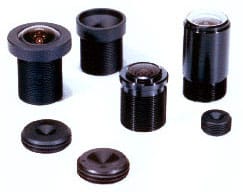High resolution lenses for macdchine vision — standard and custom lens design
Universe Optics Explains The Science Behind CCD Cameras
High Resolution Lenses for machine vision, instrumentation, inspection and vibration-sensitive applications. Standard and custom hi-res lens assemblies.

CCD Cameras
What is a CCD camera? The term CCD means “charge-coupled device.” CCD cameras were developed and introduced in the 1960s as a way to “capture and store images in a digital memory.” Since the introduction of these cameras, the technology and science behind them have continued to grow and expand into many scientific and technological areas including:
- Fax machines
- Photocopiers
- Mammography
- X-rays
- Camcorders
- Cameras
- Security surveillance technology
- Astronomical research
Today’s CCD cameras incorporate image sensors that capture and store the digital images.
How did CCDs come to light?
Inventors Willard Boyle and George E Smith at Bell Labs first introduced the cameras. The inventors first imagined the CCD as a computer memory circuit; these circuits are light sensitive and have a silicon finish. Once the inventors realized that these CCDs could capture higher quality images if they were placed inside a camera (or other housing) the technology advanced. With a CCD the more light that is collected, the clearer the captured image will appear.
How does a CCD work?
Since the advent of digital cameras, the CCD is an integral part as it works as the camera’s image sensor. The light collected within the camera is focused onto the CCD’s silicon finish and the image sensor then captures that light, converts into electrical charges (electrons) and then become a digital image. All of this happens at the push of the button that opens the camera shutter.
The benefits of CCD technology
Capturing images of high quality with low-noise and high pixel rates are the major benefits of this technology within the camera. Because digital cameras measure light on the color spectrum of red, green and blue the image quality hinges on the overall quality of the camera (and it’s CCD sensor) you purchase.
Today’s CCD cameras house from one to three CCD arrays, these arrays translate the hues. When considering the uses for a CCD camera, consider that a one-array CCD is the typical camera utilized in security surveillance; the reason for this is that precise colors are not usually needed.
The CCD camera technology used in science and astrophotography allow for long exposure which is crucial when used in devices such as the Hubble Telescope. In this device, the “camera replaces the eyepiece of the telescope and is then connected to a computer.” CCD cameras can operate and capture up to 70 percent of the ambient light, compare that to the usual two percent that traditional cameras can capture and that translates into higher quality images being captured.
The type of CCD camera used will hinge on the way in which you plan to use it. If you’re going to attach the camera to a telescope or microscope, and this can be accomplished by using a C-mount adapter, you need to purchase a camera for that specific purpose. Traditional cameras capture high quality images based on the quality of the CCD image sensor housed within, the higher quality the sensor, the higher quality the final image will be.
Universe manufactures standard and custom CCD/CMOS lens assemblies for board and miniature camera applications including digital photography, video conferencing, surveillance, barcode scanning, machine vision and medical systems.